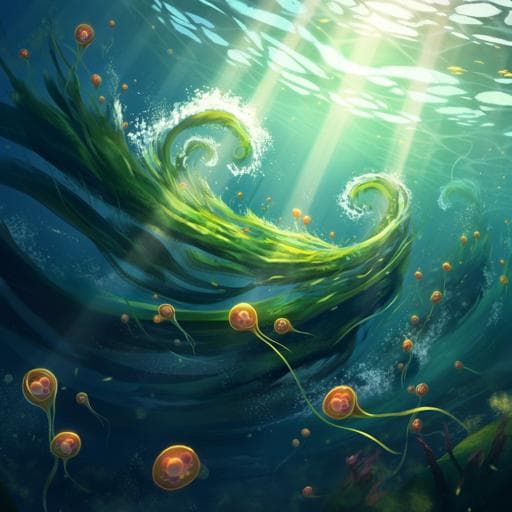
Earth Sciences
Substantial loss of isoprene in the surface ocean due to chemical and biological consumption
R. Simó, P. Cortés-greus, et al.
Dive into the fascinating world of isoprene emissions with groundbreaking research conducted by Rafel Simó, Pau Cortés-Greus, Pablo Rodríguez-Ros, and Marta Masdeu-Navarro. Discover how the constant chemical loss and biological consumption rates relate to oceanic chlorophyll-a concentrations, influencing atmospheric chemistry and climate like never before.
~3 min • Beginner • English
Introduction
The study addresses the poorly constrained oceanic sinks of isoprene, a reactive biogenic volatile organic compound that affects atmospheric ozone and secondary organic aerosol formation. While phytoplankton produce isoprene and surface ocean concentrations are widespread (∼1–100 nmol m⁻³), global ocean emissions remain uncertain, with top-down and bottom-up estimates differing by up to two orders of magnitude (∼0.1–12 TgC yr⁻¹). This discrepancy may arise from inadequate representation of oceanic degradation processes. Chemical oxidation in seawater is assumed based on isoprene’s reactivity, and isoprene-degrading bacteria have been reported, but in situ rates of chemical and biological consumption at natural concentrations have not been experimentally quantified. The research aims to determine and quantify chemical and biological isoprene consumption in the surface ocean and to evaluate their variability and relative importance compared to ventilation and vertical mixing, providing a predictive framework for isoprene loss in models.
Literature Review
Prior work has estimated marine isoprene emissions using top-down atmospheric inversions and bottom-up ocean concentration and flux models, with large discrepancies. Photochemical production at the sea surface microlayer has been demonstrated but is insufficient to close the gap. Chemical oxidation in seawater has been inferred from known reaction kinetics (e.g., with OH) but not directly measured under natural conditions. Evidence exists for marine isoprene-degrading bacteria (notably Actinobacteria; potential involvement of SAR11) and for links between isoprene production and phytoplankton physiology, stress, temperature, and chlorophyll-a. Models have commonly applied a fixed chemical loss term and either fixed or chlorophyll-linked biological loss to balance observed concentrations. However, direct experimental constraints on in situ consumption rates have been lacking, and the relative roles of microbial catabolism versus reactions with photochemically or biologically derived oxidants (e.g., H₂O₂, HOBr) remain uncertain.
Methodology
- Study regions and sampling: Offshore surface seawater samples were collected at 11 sites spanning the Mediterranean Sea, Atlantic Ocean, tropical Pacific near Mo’orea, and the Antarctic/Subantarctic (40°N to 61°S), covering wide ranges of sea surface temperature (−0.8 to 28.6 °C), wind speed (3–12 m s⁻¹), chlorophyll-a (0.1–5.8 mg m⁻³), and isoprene (4–104 nmol m⁻³). One site was on the SW Atlantic shelf. Coastal seawater for kinetics and oxidation assays was collected at Blanes Bay (NW Mediterranean), Barceloneta (near seaweeds), and Mo’orea lagoon. Physical parameters (temperature, salinity) were measured with CTDs or underway systems; some cruises used Lagrangian drifters to maintain water-mass tracking.
- Incubation design (loss kinetics): For coastal kinetics, duplicate 2 L all-glass bottles were filled without headspace and incubated in the dark at in situ temperature; multiple time points over up to 45 h were sampled to fit decay kinetics. Headspace introduced during subsampling was corrected using Henry’s law temperature dependence. Offshore loss experiments used duplicate 0.5 L headspace-free glass bottles: one set analyzed immediately for initial isoprene; the other incubated 24 h (one case 9 h) in the dark at in situ temperature (flow-through seawater bath) and then analyzed. Loss rate constants (k_loss, d⁻¹) were estimated as slopes of ln(concentration) versus time, assuming first-order loss and minimal dark production; standard error of slope provided uncertainty.
- Chemical versus biological loss assays: To isolate chemical oxidation, coastal water was sequentially filtered (3 µm and 0.2 µm). Filtrate filled series of 30 mL gas-tight vials for treatments: (i) filtered only, (ii) +10 µmol L⁻¹ H₂O₂, (iii) +0.0025 U mL⁻¹ bromoperoxidase (BrPO; Corallina officinalis enzyme), (iv) +H₂O₂+BrPO. A non-filtered series served as reference. All incubations were dark at in situ temperature (24 ± 0.5 °C). Isoprene was measured at successive times by sacrificing vials.
- Isoprene analysis: Purge-and-trap GC–MS (Agilent 5975-T LTM GC/MS) with VOCARB 3000 trap. 25 mL aliquots were purged with He (40 mL min⁻¹, 12 min, 30 °C), desorbed at 250 °C, and analyzed (SIM m/z 67; RT 2.4 min on LTM DB-VRX at 35 °C). Detection limit 1 pmol L⁻¹; precision 5%. Calibration: gas standards (HOTMIX, TransPEGASO, PEGASO) or liquid standards in methanol/MilliQ (Mo’orea, coastal).
- Ancillary measurements: Chlorophyll-a via acetone extraction and fluorometry; bacterial abundance by flow cytometry (SYBR-Green staining) on fixed samples.
- Ventilation and mixing rate constants: Air–sea isoprene flux (F_vent) computed as k_as × [iso]_s / K_H with [iso]_air ≈ 0. Gas transfer velocity k_as estimated from wind speed U10 and Schmidt number (Sc) using Wanninkhof (2014): k_as = 0.251 × U10 × (Sc/660)⁻⁰.⁵; Sc parameterized as a function of SST. Ventilation rate constant k_vent (d⁻¹) obtained by dividing F_vent by mixed-layer depth (Z_ML) and [iso]; Z_ML from CTD density criterion or climatology (Holte et al. 2017). Uncertainty on ventilation flux ~20%.
- Vertical mixing (k_mix): For three Southern Ocean sites with vertical profiles, turbulent diffusion flux at ML base: F_mix = K_z × (Δ[iso]/Δz), using K_z = 2.6 m² d⁻¹ (0.3 cm² s⁻¹) as a conservative Southern Ocean value. k_mix (d⁻¹) = F_mix / ([iso]_surface × Z_ML). For other sites, k_mix set to −0.005 d⁻¹ (import) from a global model. Sensitivity to K_z (0.1–1.0 cm² s⁻¹) had minor impact on k_prod.
- Data analysis and modeling relationships: First-order loss verified to fit better than zero-order in coastal kinetics. Offshore k_loss values regressed against chlorophyll-a to derive an empirical relationship. Conversion between in situ fluorometric chlorophyll-a and satellite chlorophyll-a used a global match-up: [chla_sat] = 0.79 × [chla]^0.78, enabling a satellite-based k_loss predictor. Under steady state over 24 h, k_prod was inferred as k_loss + k_vent (± k_mix sign-dependent), and chla-normalized specific production rates were computed.
Key Findings
- Demonstrated sustained isoprene loss in dark, headspace-free seawater incubations over ≥45 h with first-order decay, indicating consumption in seawater independent of ventilation and light-driven production.
- Coastal filtration experiment indicated roughly half the total loss was abiotic chemical oxidation: unfiltered k ≈ 0.20 d⁻¹ vs filtered k ≈ 0.12 d⁻¹. Chemical loss was substantially accelerated by additions: +10 µM H₂O₂ increased loss to 0.91 d⁻¹; +0.0025 U mL⁻¹ BrPO to 0.31 d⁻¹; combined H₂O₂+BrPO caused complete removal in <4 h, implicating HOBr formation and reactivity.
- Open-ocean total loss rate constants (k_loss = k_bio + k_chem) ranged 0.03–0.64 d⁻¹ (median 0.08 d⁻¹) across 11 sites and were strongly correlated with chlorophyll-a: k_loss = 0.10 (±0.01) × [chla] + 0.05 (±0.01) (R² = 0.96, p = 1e−7, n = 11). The intercept represents a chemical oxidation term k_chem ≈ 0.05 ± 0.01 d⁻¹.
- Biological consumption term (k_bio) inferred as the variable component (0 to 0.59 d⁻¹; median 0.03 d⁻¹), scaling with [chla]. No significant correlation with total bacterial abundance, suggesting roles for specific degraders and/or biogenic oxidants.
- Satellite-compatible predictor: using [chla_sat] = 0.79 × [chla]^0.78, recommended k_loss ≈ 0.14 × [chla_sat]^1.28 + 0.05 d⁻¹.
- Comparison with physical sinks: k_loss was 0.4–10× k_vent (median 1.2), showing that microbial + chemical consumption is often comparable to or exceeds ventilation. Vertical mixing was generally a minor term and often an import into the mixed layer.
- Total isoprene turnover times (1/(k_loss + k_vent + k_mix)) ranged 1.4–16 days (median 5 days); shorter in productive waters.
- Isoprene specific production rates (chla-normalized) spanned 1–38 nmol (mg chla)⁻¹ d⁻¹ (median 8), within and often at the high end of monoculture-derived ranges. Specific production increased exponentially with temperature from −0.8 to 23 °C and declined at higher SST, consistent with enzyme-like thermal responses.
- Implications: Biological consumption is variable and can dominate over ventilation in chlorophyll-rich conditions; chemical loss is non-negligible and likely involves both photochemically and biologically derived oxidants.
Discussion
By directly quantifying first-order loss of isoprene in dark seawater incubations, the study confirms that substantial in situ consumption occurs via both chemical oxidation and microbiota-dependent processes. The strong dependence of total loss on chlorophyll-a links consumption to ecosystem productivity, indicating that higher phytoplankton biomass and associated microbial activity and/or biogenic oxidants increase isoprene removal. The constant intercept in the k_loss–[chla] relationship supports a pervasive chemical oxidation term (~0.05 d⁻¹) consistent with prior model prescriptions based on oxidative transients (e.g., OH). The biological consumption term varies widely, aligning with modeling needs for a variable k_bio rather than a fixed value. Comparisons with air–sea exchange show that oceanic consumption rates are often of similar magnitude to, or exceed, ventilation, challenging the assumption that ventilation dominates surface ocean isoprene loss. Consequently, surface isoprene concentrations and fluxes cannot be predicted solely from production proxies; they require accounting for dynamic biological and chemical sinks. The satellite-based k_loss parameterization offers a practical pathway to incorporate variable consumption into global models.
Conclusion
The study provides the first experimental constraints on both chemical and biological consumption of isoprene in the surface ocean at natural concentrations across diverse regions. It establishes a robust empirical relationship between total loss rate and chlorophyll-a with a constant chemical term, demonstrating that oceanic consumption can rival or surpass ventilation, especially in productive waters. The work revises the marine isoprene cycle by highlighting the variability and significance of biological sinks and the role of biogenic oxidants. It recommends implementing a [chla]-based variable consumption term in models, including a satellite-compatible formulation, to better predict isoprene concentrations and emissions. Future research should identify the microorganisms and pathways responsible for biological consumption, quantify the contributions of specific oxidants (e.g., H₂O₂, HOBr, OH) under natural light regimes, expand in situ measurements under varying environmental conditions, and refine temperature dependencies of production across taxa.
Limitations
- Incubations were conducted in the dark, assuming isoprene production is arrested; residual dark production may occur, potentially underestimating loss rates.
- Limited number of offshore experiments with uneven distribution along the chlorophyll-a gradient; k_bio is poorly constrained in very low-[chla] waters (<0.4 mg m⁻³), which cover large ocean areas.
- Chemical oxidation pathways and oxidant concentrations (e.g., H₂O₂, HOBr, OH) were not quantified in situ; additions in assays used elevated levels relative to ambient.
- Ventilation (k_vent) and mixing (k_mix) estimates rely on parameterizations and assumed or climatological mixed-layer depths; gas transfer velocity has ~20% uncertainty; K_z variability has minor but non-zero effects.
- Bacterial abundance measurements do not directly resolve activity or specific degrader taxa; attribution of k_bio to particular microbes remains inferential.
- Conversion between fluorometric and satellite chlorophyll introduces additional uncertainty into the satellite-based k_loss parameterization.
Related Publications
Explore these studies to deepen your understanding of the subject.







